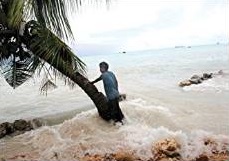By Alyssa Kutner, Summer Legal Intern
 President Barack Obama made an announcement on Wednesday, July 16th introducing a plan to improve the nation’s ability to adapt to climate change through investing in and planning a more climate-resilient infrastructure. Included in the announcement were new programs designed to increase the adaptive flexibility of the country, such as a $10 million Federal –Tribal Climate Resilience Partnership and Technical Program providing adaptation training to tribes and a $13.1 million 3-D Elevation Program, which will provide advanced data and tools to aid communities in preparing for a changing climate.
President Barack Obama made an announcement on Wednesday, July 16th introducing a plan to improve the nation’s ability to adapt to climate change through investing in and planning a more climate-resilient infrastructure. Included in the announcement were new programs designed to increase the adaptive flexibility of the country, such as a $10 million Federal –Tribal Climate Resilience Partnership and Technical Program providing adaptation training to tribes and a $13.1 million 3-D Elevation Program, which will provide advanced data and tools to aid communities in preparing for a changing climate.
One particularly interesting component of the plan is a provision on accounting for climate change in state hazard mitigation planning. Hazard mitigation planning is the practice of identifying regulations and courses of action that will minimize future state loss from disaster. If a state prepares only for current flood levels, it is likely that in the future the state’s hazard mitigation preparation will be inadequate to protect homes and families. Incorporation of climate change hazard mitigation planning would address this issue by requiring states to consider how best to anticipate future impacts from climate change, like droughts, flooding, or extreme temperatures. This means, for example, that a state hazard mitigation plan would prepare not only for seasonal flooding, but also take into account climate variability considerations such as sea level rise and the possibility that flood levels will increase over time.
Under the Disaster Mitigation Act of 2000 (42 U.S.C. §5165), states are required to file mitigation plans in order to qualify for aid from several different disaster assistance programs, but prior to Obama’s July 16th announcement there was no expectation that states identify specific climate variability issues in order to receive the grant money. According to a CCCL report issued last year, which ranked the degree of state climate preparation in State Hazard Mitigation Plans of all fifty states, the failure of the Disaster Mitigation Act of 2000 to require any type of climate preparation led to “uneven treatment of the issue” and “missed opportunities for mitigation planning”[1] across the fifty states. Without any requirement, states that do not mention climate change in their State Hazard Mitigation Plans often “rely solely on past incidences of hazard events to forecast future risk.”[2] This method fails to take into account increasingly severe hazard risk from climate variability. Other states simply reference a need for further research into climate-related issues, but do not incorporate it into their mitigation plans. State Hazard Mitigation Plans across the United States range from “not discussing [climate change] at all and missing the planning opportunity that comes with such a discussion to including an in-depth discussion that prepares state hazard mitigation teams for future hazards.”[3]
The new provision may be an important step in rectifying this concern. The Federal Emergency Management Agency (FEMA) is the agency in charge of drafting the new hazard mitigation guidelines. If FEMA makes the provision mandatory, then a state could be rendered ineligible to receive federal disaster aid funding if it fails to identify future risks and hazards that could result from climate variability. Concerns over a loss of funding would provide incentive for states to address climate variability. Further, a mandatory stipulation would induce states to not only carefully consider potential effects of climate variability, but to do so publicly in a formal plan. This would aid the political and social visibility of climate change in the community, which could foster grassroots efforts in adaptation. However, FEMA has not yet made clear if identifying climate variability issues will be mandatory for states. If the new guidelines are voluntary, it is unclear how effective the plan will be in resolving inequalities among state hazard mitigation plans.
[1] Matthew Babcock, State Hazard Mitigation Plans & Climate Change: Rating the States, The Center for Climate Change Law at Columbia Law School (November 2013), available at https://web.law.columbia.edu/sites/default/files/microsites/climate-change/files/Publications/Students/SHMP%20Summary%20of%20Survey_Final%20w%20errat.a.pdf at 1.
[2] Id. at 8.
[3] Id. at 11.




